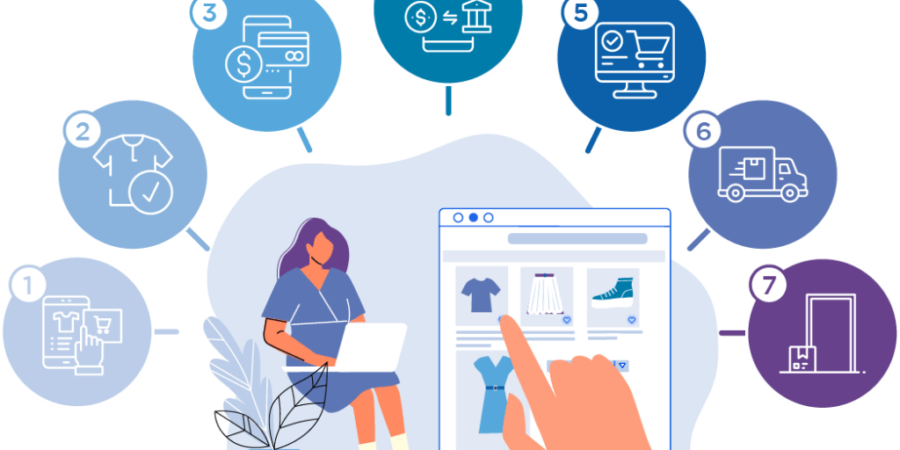Selling products and services over the internet has become a staple of modern commerce. That shift is here to stay, presenting opportunities for small business owners to thrive online. But before you set up your internet shop, you have to understand how it all works.
Editor’s note: Looking for the right tools to help build your business website? Fill out the questionnaire below to have our vendor partners contact you about your needs.
What is e-commerce?
E-commerce is the process of selling goods and services online. Customers come to the website or online marketplace and purchase products using electronic payments. Upon receiving the money, the merchant ships the goods or provides the service.
E-commerce has been around since the early 1990s when Amazon just sold books. Today, it’s a multibillion-dollar industry. According to Statista, the U.S. e-commerce industry is expected to eclipse $1 trillion in value in 2024, making it a major economic staple for the national economy.
How does e-commerce work?
E-commerce works on the same principles as a physical store. Customers come into your e-commerce store, browse products and make a purchase. The big difference is they don’t have to get off their couch to do so, and your customer base isn’t limited to a specific geographic area or region.
Whether you’re selling running shoes or home supplies, you go through the same process when operating an e-commerce website:
Accept the order. The customer places an order on your website or e-commerce platform. You’ll be alerted that an order was placed.
Process the order. Next, the payment is processed, the sale is logged, and the order is marked complete. Payment transactions are usually processed through what is known as a payment gateway; think of it as the online equivalent of your cash register. [Read related article: What Is a Merchant Account, and Do You Really Need One?]
Ship the order. The last step in the e-commerce process is shipment. You have to ensure prompt delivery if you want repeat customers. Thanks to Amazon, consumers are used to getting items within two days.
To show how it works in action, here’s a look at a product’s journey when it is purchased online:
A customer visits your online shop and browses your products. She settles on a shirt. She chooses the size and color and adds it to the shopping cart.
An order manager or order management software confirms the product is in stock.
If the product is available and the customer is ready to check out, she enters her payment card details and shipping information on your payment form or page.
The payment processor, typically a bank, confirms the customer has enough cash in the bank or enough credit on her card to complete the transaction.
The customer gets a message on the website that the transaction went through. This all happens in seconds.
The order is dispatched from the warehouse and shipped. The customer will receive an email that the product is out for delivery.
The order is delivered, and the transaction is complete.
Key Takeaway
E-commerce transactions are similar to physical retail transactions in that customers come into your store, shop for products and check out. The difference is that it is done digitally and you have to ship the items to your customers.
What features should an e-commerce site have?
To be successful at electronic commerce, you should have a comprehensive list of the products and services you sell on your website or marketplace page. The online shop should be easy to navigate, user-friendly and aesthetically appealing. It should also be optimized for mobile devices.
The checkout experience is another important aspect of e-commerce functionality. It is the process the customer goes through to buy your product or service. If your checkout process is clunky and cumbersome or requires too many steps, you may lose the sale. Shopping cart abandonment is a real phenomenon, with the Baymard Institute finding the average abandonment rate stands at nearly 70 percent.
What are the pros and cons of operating an e-commerce business?
Pros of running an e-commerce business
There were lots of reasons to start an online retail business before the pandemic, and there are even more now. Here are seven of the main ones.
It has fewer overhead costs than a physical store. A big expense of running a retail business is the physical storefront. That means money spent on rent, utilities and other such needs. All of that goes away when you operate an e-commerce store. There is no rent to pay. You don’t have to worry about keeping the lights on, nor do you have to pay to have the lawn mowed or the walkways shoveled.
You can operate 24/7 with no staff. The internet doesn’t have store hours. It is up 24/7, and so is your e-commerce business. Unlike a physical store with set hours, your site can accept orders whenever your customers are ready to buy, which can drive more business. If you use software to automate most of the process, you won’t need to hire an ordering manager to work the night shift.
Your business can scale on the fly. There are physical limits to how many products you can stock when you operate a brick-and-mortar store – you have only so much shelf space. There are no such limits with e-commerce; you can add and remove products as you see fit.
You can reach more customers. Your business may be in New York, but you can sell to customers in California if your store is online. “E-commerce changes the game for small business,” said Ben Richmond, U.S. country manager at Xero. “It doesn’t matter if you’re in a city or in a small regional town – e-commerce gives you the opportunity to live where you want and sell into many markets.”
It’s easy to track your sales and shipments. Logistics are make-or-break for e-commerce companies. Thanks to the digital nature of e-commerce, it’s easy to track sales and shipments. The benefit of having this information in real time is that it allows you to quickly identify and rectify any snafus.
It compiles customer data. When you sell products online, you capture a lot of customer data, from addresses to emails. You can also glean information about their purchasing preferences. You can use these insights to target loyal customers with promotions and discounts.
It’s pandemic-proof. While brick-and-mortar businesses were forced to close their doors amid the pandemic, online businesses were able to stay open. As a result, consumers have shifted their shopping habits, making it a necessity for every retailer to run an online store. “As more consumers are shifting their spending from visiting brick-and-mortar stores to online shopping, businesses need to shift too,” Richmond said.
Cons of running an e-commerce business
Though e-commerce has many benefits, it’s not without its challenges. Here are six to consider before you decide if an e-commerce business is right for you.
You can’t reach everyone. Even amid the pandemic, there are still consumers who simply don’t like shopping online; they want to see and touch products before they buy, and they are afraid of online fraud. According to Oberlo, 2.77 billion people are projected to shop online in 2025 – but that’s out of the 7.8 billion people worldwide..
Data and credit card fraud are rampant. One of the biggest problems with e-commerce is the risk of fraud. Credit card and identity theft are commonplace, affecting thousands of consumers annually. If hackers breach your network and steal sensitive customer information, it could cause irreparable damage.
Customers abandon their shopping carts. E-commerce makes it easier for customers to window-shop with little intention of buying. Shopping cart abandonment impacts a high percentage of online sales.
There are costs for doing business online. You may not have the overhead physical retailers have, but there are still costs to consider, such as website hosting and/or e-commerce platform fees, internet service costs, social media marketing, inventory management, and storage and shipping. Like any other business owner, you must also consider applicable taxes, business licenses and regulations.
E-commerce is a cutthroat business. You aren’t the first person to sell a product or service online; depending on your industry, you may have many competitors with identical or very similar products. Since many consumers shop based on price and expect to find good deals on the internet, you may find yourself in a race to the bottom.
Customers want fast, free shipping. Physical retailers don’t have to worry about packaging and shipping their products. An online retailer does. Amazon has taught customers to expect not only two-day shipping, but also free shipping – which you may not be able to afford to offer.
Key Takeaway
An e-commerce business can help you save money on overhead, expand your customer base and track sales, but it also has risks. Payment and data fraud, fierce competition, and discount-seeking consumers are ongoing challenges.
Types of e-commerce business models
There are several different e-commerce business models, based on what is being sold and to whom. These are the three most common types.
Business to consumer (B2C): This type of business sells products or services directly to the individual consumer. B2C e-commerce is the most common online business type and covers a broad array of products, from clothing to entertainment. Examples of B2C e-commerce stores include Amazon, Netflix and Overstock. Most established retailers, from Nike to Tommy Bahama, operate this type of e-commerce site.
Business to business (B2B): When a business sells products or services to another business online, it is considered B2B e-commerce. These businesses might sell items such as office supplies, furniture and equipment. They also provide online business solutions, such as document-signing software and other cloud-based services.
Marketplaces: Pioneered by eBay but overtaken by Amazon, e-commerce marketplaces are websites where third-party merchants can sell their products or services to consumers. Walmart.com and Etsy are other examples of online marketplaces. For a cut of your sale, you can list your products on their platforms and access their customer bases. Many online marketplaces will handle your payment processing, logistics and even social media marketing for a fee.



Leave a Reply